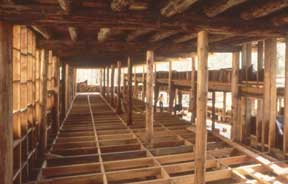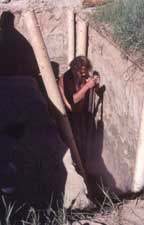
PSP construction
 In addition to the
orientation of the house, Oehler's underground
buildings are unique because of their building methods. He calls
his system PSP, which stands for Post/Shoring/Polyethylene. I'll
write about the polyethylene tomorrow, but will explain the framework
today.
In addition to the
orientation of the house, Oehler's underground
buildings are unique because of their building methods. He calls
his system PSP, which stands for Post/Shoring/Polyethylene. I'll
write about the polyethylene tomorrow, but will explain the framework
today.
Basically, Oehler's
houses are timber-frame structures sunk underground. He uses
dried and de-barked trees (western cedar and lodgepole pine) that are
six to twelve inches in diameter to form posts and beams, notching them
together so they create a rigid framework. The  inter-connected timbers hold
back the force of the hillside because each wall is braced against the
opposite side.
inter-connected timbers hold
back the force of the hillside because each wall is braced against the
opposite side.
The polyethylene layer
that I'll mention tomorrow keeps most of the wood dry, but the bottom
2.5 to 3 feet of the posts are exposed to soil moisture. Oehler
built his first houses by impregnating those portions of the wood with
penta (a chemical preservative), which he no longer advocates.
Now, he prefers to char
the wood, cool it,
then wrap each end with five layers of garbage bags.
Unfortunately, his new method doesn't have as much longevity behind it,
so you can't be sure how long it will last, but he does provide
instructions for changing out the posts in an existing house if
necessary.
| This post is part of our The $50 and Up Underground House Book
lunchtime series.
Read all of the entries: |
Want more in-depth information? Browse through our books.
Or explore more posts by date or by subject.
About us: Anna Hess and Mark Hamilton spent over a decade living self-sufficiently in the mountains of Virginia before moving north to start over from scratch in the foothills of Ohio. They've experimented with permaculture, no-till gardening, trailersteading, home-based microbusinesses and much more, writing about their adventures in both blogs and books.
Want to be notified when new comments are posted on this page? Click on the RSS button after you add a comment to subscribe to the comment feed, or simply check the box beside "email replies to me" while writing your comment.

You could splice the posts together from two kinds of wood; with the piece that goes into the ground being a rot-resistant wood like chestnut (Castanea sativa) or whatever is popular for this purpose in the US. In Europe high-grown european larix (Larix decidua) is popular for posts that have to stand in water. Making the splice is a job for a woodworker, though.
Alternatively, pour some concrete in a hole (to slightly above ground level) to make a foundation for a post. Put the post on top of that foundation. Don't pour the post into the concrete; it will still get wet and rot. Put some steel angle profiles vertically into the concrete so you can later put the post in between them.
It will depend on the location and accessibility of the property. If you can get an excavator and concrete truck in, it'll be easy.
If that is not possible, mixing the concrete locally would be a lot of work. And the resulting material would probably be less consistent. Personally I wouldn't even consider it if I didn't have a way of carrying the bags of cement and aggregate in by vehicle!